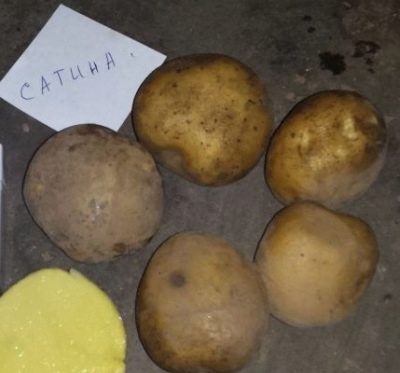
- Authors: Solana, Germany
- Name synonyms: Satina
- Appointment: dining room
- Tuber size: large
- Tuber weight, g: 90-130
- Peel color: light yellow
- Color of the pulp: yellow
- Starch content,%: 12,6-14,1%
- Tuber shape: oval
- Keeping quality: high
Satina potatoes of German origin are a unique combination of excellent taste and excellent quality of root crops. The variety, unpretentious to the soil, demonstrates excellent productivity and resistance to many pests and diseases.
Breeding history
Scientists from Germany, the Solana company, were engaged in breeding the variety, who after a few years managed to get a bush that could quickly adapt to various growing conditions.
Description of the variety
The main characteristics of Satina potatoes:
bushes - powerful and compact;
the spreading of the stems is moderate;
leaves are large, rich green hue.
During active flowering, the bush forms small cream-colored buds. The roots develop well, which guarantees large fruits. The culture is also characterized by resistance to heat and drought, common diseases.
Characteristics of the appearance of the bush and root crops
Small bushes with powerful stems give most of the nutrients to root crops. Specifications:
shape - mostly oval;
fruit weight - up to 130 g;
the peel is dense, light yellow;
the color of the pulp is yellow.
During cooking and cutting, the pulp darkens.
Purpose and taste of tubers
The average percentage of starch content in raw tubers reaches 14%. Medium boil-over makes it possible to prepare most of the second courses. Potatoes are great for soups as well as salads and frying.
Maturation
Root crops are formed closer to 85 days after planting. After this period, you can harvest.
Yield
The average yield from 1 hectare is 420 centners.
Growing regions
Potatoes are in demand in many regions of the country. It is grown both in the west and south, and even in the northern regions. Among other things, the variety is popular in the CIS countries: in Belarus, in Ukraine.
Growing and care
It is recommended to plant Satin potatoes after frosts, when the ground temperature rises to +8 degrees and above. Before proceeding with planting root crops, they must be prepared. Stages.
Selection. Tubers are pre-selected, leaving large or medium and undeformed samples.
Drying and germination. The selected potatoes are placed in a box, which is then placed in a well-lit and warm place for 3 weeks. During this time, the potatoes will sprout up to 3 cm long.
Treatment. Root crops ready for planting are treated with growth stimulants and protective compounds a day before moving into the ground.
The planting scheme for Satin potatoes is as follows.
Dig holes, leaving 60 cm between the rows, 35 cm between the bushes.
A layer of wood ash or organic fertilizers is laid in the finished pits.
Place the tuber.
After the root crop is buried. When the entire area is planted, it is watered abundantly with warm water. Next, you should take care of timely care.
Watering. The first time after planting, the bushes are watered immediately after the first shoots appear. The minimum volume per bush is 3 liters. Further, water is added during the flowering period and the formation of tubers. When the potatoes have faded, watering should be stopped.
Hilling. An obligatory procedure, which is carried out 2-3 times per season. The soil for hilling is taken between the rows. The procedure increases the yield of potatoes by 30%, and also accelerates the growth of roots.The first time they spud the bushes 1-2 weeks after germination, then every 2 weeks.
Top dressing. Satina potatoes are undemanding to regular fertilization. Top dressing is recommended to be used during flowering and fruiting, giving preference to organic matter.
Weeding. Removing weeds prevents the spread of diseases and pests and improves the taste of the tubers.
Taking into account the listed recommendations for growing and caring for Satina will allow you to get a rich harvest.

Planting potatoes is one of the main spring activities traditional for Russian gardeners. There are many ways to plant this vegetable, allowing you to get a good harvest in different conditions and climates. Before planting, you need to carefully prepare the planting material, correctly determine the timing, competently prepare the soil.


Soil requirements
The Satina variety is not too picky about the soil. Recommendations for choosing a site for planting:
preference should be given to sunny and draft-free places;
it is better to plant potatoes in light and crumbly soils, which include sandy loam or black soil;
before planting, it is worthwhile to apply organic fertilizers and loosen the soil in order to saturate it with oxygen and evenly distribute the fertilizing.
Additionally, you should pay attention to the acidity and the level of groundwater. The first, if necessary, is reduced with alkaline compounds. If the groundwater flows high, a drainage system should be provided. Otherwise, the crop will rot.

Disease and pest resistance
A common pest of Satin potatoes is the larva of the click beetle. And also the Colorado potato beetle is capable of causing harm to the plant. Preventing the spread of insects through the bushes will help preventive treatment of tubers before planting, as well as spraying potatoes during the growth period.
Quite rarely, bushes are exposed to late blight of the tops. Treatment with compounds containing copper or a solution of copper sulfate will help protect potatoes from disease. To keep the disease from spreading, it is also recommended to take care of the care.

Potatoes are a popular vegetable crop that many gardeners planted on their site. But growing a bountiful harvest of tasty and large tubers is unlikely to succeed if the beds are not properly protected from the most common diseases and pests. Often, the development of diseases of various etiologies of potatoes goes unnoticed, so it is important to identify the problem in time and eliminate it.
















































































